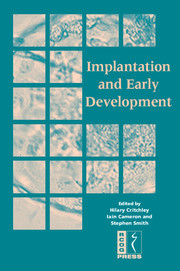
- Publisher:
- Cambridge University Press
- Online publication date:
- June 2014
- Print publication year:
- 2005
- Online ISBN:
- 9781107784680
Last updated 10th July 2024: Online ordering is currently unavailable due to technical issues. We apologise for any delays responding to customers while we resolve this. For further updates please visit our website https://www.cambridge.org/news-and-insights/technical-incident


Successful implantation and early development need a union of healthy genes and an optimal uterine environment. The 48th RCOG Study Group, an international multidisciplinary expert forum, considered factors involved in preparation for implantation within the uterus; how to determine a good egg and good sperm; lessons from animal models; transgenic and genomic technologies; sporadic and recurrent early pregnancy loss; single-embryo transfer; and the developmental consequences of assisted reproduction technologies. This book presents the findings of the Study Group, with sections covering:preparation for implantation - the uterine environmentthe embryolessons from animal models (transgenics) and novel technologiesclinical sequelae.
 Loading metrics...
Loading metrics...
* Views captured on Cambridge Core between #date#. This data will be updated every 24 hours.
Usage data cannot currently be displayed.